 German Empire (1901): Prinz Adalbert, Friedrich Carl
German Empire (1901): Prinz Adalbert, Friedrich CarlWW1 German Cruisers
Irene class | SMS Gefion | SMS Hela | SMS Kaiserin Augusta | Victoria Louise class | Prinz Adalbert class | SMS Prinz Heinrich | SMS Fürst Bismarck | Roon class | Scharnhorst class | SMS BlücherBussard class | Gazelle class | Bremen class | Kolberg class | Königsberg class | Nautilus class | Magdeburg class | Dresden class | Graudenz class | Karlsruhe class | Pillau class | Wiesbaden class | Karlsruhe class | Brummer class | Königsberg ii class | Cöln class
Standard Armored Cruiser – The Prinz Adalbert class:
After Fürst Bismarck (1897), the first German armoured cruiser, Prinz Heinrich (1900) setup the standard for future armored cruisers, and its design was found so successful it was just upgaded on three successive classes until the arrival of the Dreadnought: The Prinz Adalbert, Roon, and Scharnhorst class.
The new cruisers benefited from incremental improvement with a slightly revised armor layout for internal protection, revised main battery, more powerful propulsion for a better speed. Prinz Adalbert was a gunnery training ship before 1914 while Friedrich Carl served as the flagship of the fleet’s reconnaissance forces, replaced in 1909 and becoming a training vessel. In July 1914, both were mobilized, Friedrich joining the cruiser squadron in the Baltic Sea (sunk by mines off Memel in November 1914) and Prinz Adalbert initially served in the North Sea, supporting the Raid on Yarmouth in November 1914 before transferring to the Baltic to replace her lost sister. Prinz Adalbert was torpedoed by British submarines twice in 1915, the second time in October led to a catastrophic explosion that vaporized the ship into smitherine.
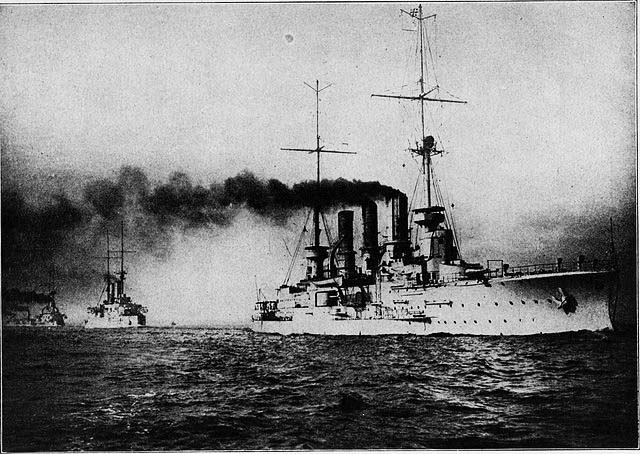
Both Prinz Adalbert class cruisers in fleet execises, underway circa 1911
Design development
The First Naval Law in Germany which was passed in 1898 planned twelve armored cruisers, all intended as replacement for proper battleship, in overseas service based in German colonies. Aside this, the Kaiserlisched Marine (German Navy) required cruisers for fleet operations so a compromise was to be fin both in design and use. Due to budget constraints, it was decided these cruisers should perform both roles, mainly conolial station in peacetime and fleet ops in wartime. This law generated SMS Prinz Heinrich, an alteration of the Fürst Bismarck, on budget. The law defined one large cruiser yearly, so as soon as the Prinz Heinrich was in construction, design work started on the follow-on armoured cruiser.
Design
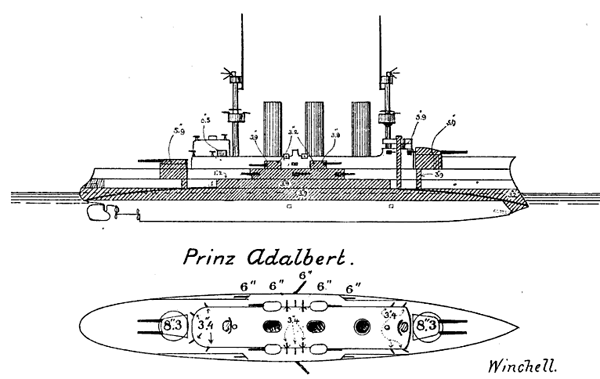
Brassey’s design schematics
The design was prepared in 1899–1900, as basically an improvement on Prinz Heinrich, which contained all the innovative solutions needed for future developments. Its basic hull size and general shape was the same, with some proportions increased, while the armament and armor layout were improved.
Armament
The previous ships had two slow firing 24 cm main guns, one fore and one aft, so it was chosen instead Four lighter, quick-firing 21 cm (8.3 in) guns, in twin turrets. Indeed in between debates within the design staff concluded that it was more efficient to trade two heavy shells for a broadside of four in half the time. These 21 cm became standard from then on, for all armored cruisers which followed. Their secondary battery was was essentially the same as on Prinz Heinrich, with just two more 8.8 cm (3.5 in) guns.
Main battery: Four (2×2) 21 cm (8.3 in) SK L/40 guns.
-Depression −5°, elevation to 30°
-Maximum range 16,300 m (53,500 ft)
-238-pound (108 kg) shell
-Muzzle velocity of 780 m (2,560 ft) per second
-Ammo carried: 340 rounds total, 85 per gun.
Secondary armament: Ten (10) 15 cm (5.9 in) SK L/40 guns mounted in casemates
-Mounted single amidships both sides, plus four twin turrets above.
-Elevation 30°, muzzle velocity 800 mps
-Maximum range of 13,700 m (44,900 ft)
-40 kg (88 lb) HE shell
-Total supply: 1,400 shells, 140 per gun.
Tertiary armament: Twelve (12) 8.8 cm SK L/35 guns
-Two groups of four, shielded, pivot.
-Mounted close to the Forward conning tower, funnels amidships, rear superstructure.
-Elevation 25°
-Range 9,090 m (29,820 ft)
-Muzzle velocity 770 mps (2,530 ft)
-7 kg (15 lb) shell
Also, Four 45 cm (17.7 in) submerged torpedo tubes were mounted in the bow, stern, and broadsides. A supply of eleven torpedoes was provided.
Armor Protection
Basically all figures and the general scheme remained the same as on Prinz Heinrich, but with a comprehsenive improvement: Now the upper belt was connected to the main battery barbettes, by oblique armored bulkheads. Decks had also thicker plates:
-Steel armor (cemented) by Krupp.
-Main belt armor 100 mm (3.9 in) +50 mm (2 in) teak central section, over machinery and ammunition.
-Outer belt 80 mm (3.1 in), unprotected bow and stern.
-Armored decks 40 mm to 80 mm.
-Sloped armor 50 to 80 mm, connecting the deck and armored belt.
-Casemate and turrets for 15 cm guns: 100 mm.
-21 cm gun turrets: 150 mm (sides), 30 mm roofs.
-Forward conning tower: 150 mm walls, 30 mm roof.
-Rear conning tower 20 mm walls.
-Hull subdivided into fourteen watertight compartments
-Double bottom for 60% lenght
-Heavy military masts (back again)
Powerplant
There was a new propulsion system, producing 10 % more output, helping to achieve an increase of 0.5 knots (0.93 km/h; 0.58 mph) a welcome improvement over the Prinz Heinrich which was generally seen as too slow. The hull lines and integration of the shafts was well refined: The propeller shafts were not only better faired into the hull lines, reducing drag they were also self-supporting. This innovation was passed onto the next cruisers.
Construction
SMS Prinz Adalbert (ordered as “B”, built at the Imperial Dockyard, Kiel – construction number 27) was started in April 1900, launched 22 June 1901. The ceremony was attended by Emperor Kaiser Wilhelm II and the cruiser’s namesake and Royal brother, Admiral Prince Heinrich plus Wilhem’s son, Prince Adalbert of Prussia, while her christening was performed by Prince Heinrich’s wife. Fitting-out work was somewhat slowed down by the overworked Imperial Dockyard, but completed eventually on 12 January 1904, at a cost 16,371,000 Goldmarks. She was commissioned for sea trials that day, under command of Kapitän zur See Hermann Jacobsen. She started servce as a gunnery training ship after her sea trials were completed by 30 May.
SMS Friedrich Carl was ordered as “Ersatz König Wilhelm” provisionally, built at the Blohm & Voss shipyard, Hamburg, as yard number 155. She had her keel laying ceremony in August 1900 but her construction proceeded slowly due to the shortage of labor in the Yard, crowded with orders. She was launched almost two years later, on 21 June 1902. The launching ceremony saw Prince Friedrich Leopold of Prussia, son of the ship’s namesake making a speech, and his wife, Louise Sophie, christening her. The fitting-out work was actually faster proceeding until November 1903. Then followed her shipyard’s trials with a provisional crew under supervision of captain Kapitän zur See Johannes Merten. She then moved to be armed at Wilhelmshaven where her artillery waited. She was fully completed only by 12 December 1903, and started her official pre-commission sea trials, which were successful, but were stopped until conclusion in March 1904.
-Three 3 Vertical cylinder triple expansion engines (VTE)
-14 coal-fired Dürr water-tube boilers (Düsseldorf-Ratinger Röhrenkesselfabrik)
-Three funnels.
-Center shaft: 3-bladed screw 4.5 m (15 ft) diameter
-2 Outboard shafts: Four-bladed screws 4.8 m (16 ft).
-Shortened propeller shafts, better faired into the hull lines
-Hydrodynamic improvements all around the board
-PwP Rated for 16,200 metric horsepower (Prinz Adalbert) 17,000 PS (Friedrich Carl)
-Top speed 20 to 20.5 knots respectively.
-Coal supply 750 t in peactime, 1,630 t in wartime.
-Range 5,080 nautical miles (9,410 km; 5,850 mi) at 12 knots
-Electrical power: Four generators, 246 kilowatts (330 hp) @110 volts total.
Old author’s Profile of Prinz Adalbert
Prinz Adalbert Specifications |
|
| Dimensions | 127 x 20.4 x 7.8 m (416 oa x 66 x 25 ft) |
| Displacement | 10,690 t standard, 11,461 FL |
| Crew | 36 officers, 585 ratings |
| Propulsion | 3 shafts, 12 boilers, 3 VTE engines 13,500 ihp (10,100 kW) |
| Speed | 18.7 knots (34.6 km/h; 21.5 mph), Range: 3,230 nm (5,980 km)/12kts |
| Armament | 2×2 21 cm (8.2 in), 12 × 15 cm (5.9 in), 10 × 8.8 cm (3.5 in) SK L/30, 6 × 45 cm (18 in) TTs |
| Armor | Belt: 20 cm (7.9 in), Turrets: 20 cm (7.9 in), Deck: 3 cm (1.2 in) |
Read More:
Corbett, Julian Stafford (1921). Naval Operations: From The Battle of the Falklands to the Entry of Italy Into the War in May 1915. II.
Dodson, Aidan (2016). The Kaiser’s Battlefleet: German Capital Ships 1871–1918. Barnsley: Seaforth Publishing.
Gardiner, Robert & Gray, Randal, eds. (1985). Conway’s All the World’s Fighting Ships: 1906–1921.
Grießmer, Axel (1999). Die Linienschiffe der Kaiserlichen Marine: 1906–1918; Konstruktionen zwischen Rüstungskonkurrenz und Flottengesetz
Gröner, Erich (1990). German Warships: 1815–1945. I: Major Surface Vessels. Annapolis: Naval Institute Press.
Halpern, Paul G. (1995). A Naval History of World War I. Annapolis: Naval Institute Press.
Herwig, Holger (1998) [1980]. “Luxury” Fleet: The Imperial German Navy 1888–1918. Amherst: Humanity Books.
Hildebrand, Hans H.; Röhr, Albert & Steinmetz, Hans-Otto (1993). Die Deutschen Kriegsschiffe (Band 3)
Hildebrand, Hans H.; Röhr, Albert & Steinmetz, Hans-Otto (1993). Die Deutschen Kriegsschiffe (Band 7)
Polmar, Norman & Noot, Jurrien (1991). Submarines of the Russian and Soviet Navies, 1718–1990.
SMS Prinz Adalbert in service
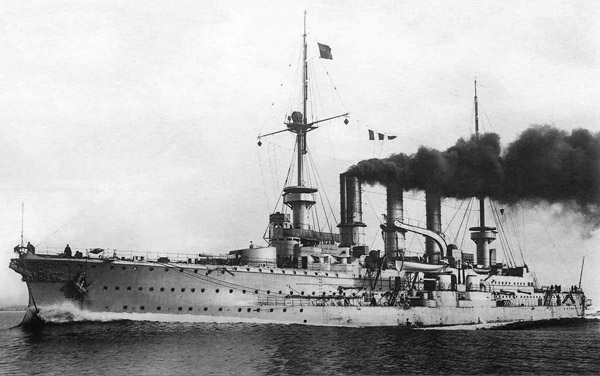
SMS Prinz Adalbert underway
Prewar service
In September 1904, as a gunnery training ship, SMS Prinz Adalbert took part in the annual autumn maneuvers with the Heimatflotte (Home Fleet). She was part of a special training unit accompanied by a flotilla of torpedo boats, created in early 1905, SMS Prinz Adalbert being its flagship, until 1907, hosting Rear Admiral Hugo Zeye. She had the honor, with the light cruiser SMS Berlin to escort the Emperor’s yacht Hohenzollern to Sweden for a Royal visit to King Oscar II. This was in July 1905. In August she joined SMS Undine and Nymphe for an exercise off Swinemünde, testing a simulated night attack by torpedo boats, attended by Konteradmiral Ludwig Schröder. The cruiser hosted the Kaiser at their conclusion, towing an old torpedo boat filled with cork used as mobile target. The cruiser missed the 1905 autumn maneuvers, in maintenance, but took place in the following naval on 13 September. On 17-28 June she became flagship of Prince Heinrich (commander of the Baltic Sea Naval Station) and participated in Norway to the coronation review of King Haakon VII.
She took part in the 1907 and 1909 autumn manoeuvers, as part as the Reserve Division (Vizeadmiral Zeye). She became flagship, III Scouting Group (Konteradmiral Johannes Merten). In March 1910 and March 1911, she made gunnery testing sessions in the North Sea and visited the Faeroe Islands, and later Ålesund in Norway in the summer 1911. She partiipated in September in the Kiel naval review in presence of Wilhelm II and Archduke Franz Ferdinand. She was decommissioned in Kiel on 29 September, SMS Blücher taking her place as the fleet’s gunnery training ship. Her overhaul took place until 1st November 1912 and she returned to her former duty at the artillery school at Sonderburg, replacing Prinz Heinrich. Nothing much happened in 1913, and until August 1914.
Operations of 1915
North Sea
In July 1914, SMS Prinz Adalbert was pressed into front-line service, levaving her peacetime training duties, under command of Kapitän zur See Andreas Michelsen. She took the lead of IV Scouting Group (Konteradmiral Hubert von Rebeur-Paschwitz) and on 26 August, sailed to rescue the light cruiser SMS Magdeburg, running aground and later scuttled before she arrived. She was transferred to the North Sea on 7 September, protecting SMS Nautilus and Albatross for their minelaying missions, accompanied by the auxiliary minelayer SMS Kaiser. They operated at the southern entrance to the Kaiser Wilhelm Canal. Prizn Adalbert also watched over the Great Belt after false intelligence pointing out a British attempt to force the Baltic. She made a sortie with the Hochseeflotte on 2–4 November.
Baltic
After SMS Friedrich Carl, her sister ship, was sunk in November 1914, SMS Prinz Adalbert was assigned to replace her in the Coastal Defense Division, Baltic, on 29 November, and later flagship, Admiral Ehler Behring (commander of the cruiser detachment) from 7 December. On the 15 December, she she teamed with Augsburg, Lübeck, Amazone, and Thetis for a sweep towards the Åland Islands, without meeting the Russian Navy. Another followed on 27–29 December, this time in escort of the battleship Kaiser Friedrich III (V Battle Squadron), off Gotland. On 6 January 1915, she particpated in another raid off Utö, discovering a Russian submarine base. Due to the shallow waters, the attack did not took place. On 22 January 1915, she made another raid to the Åland Islands, shelling Russian positions at Libau en route, but running aground off Steinort while SMS Augsburg struck a mine off Bornholm. In March, the Admiralstab (Admiralty Staff) detached the II Battle Squadron from the High Seas Fleet as a reinforcement. These were to perform diversionary attacks while German forces would try to take Memel. The German armoured cruiser operated in the Bothnian Sea, attacking Russian merchant shipping in March.
Kounteradmiral Behring conducted another raid in 13-17 April from his admiral ship and Thetis, Lübeck, supporting the minelayer SMS Deutschland, operating off Dagö Island. Admiralstab afterwards reorganized the Baltic Sea forces and Konteradmiral Albert Hopman took command while captain Michelsen (promoted) was replaced by Kapitän zur See Wilhelm Bunnemann. Hopman departed Kiel for Danzig on 27 April 1915 while Paul von Hindenburg, was preparing a major assault on Libau. The Baltic squadron was deployed in support, bolstered by the pre-dreadnoughts of the IV Battle Squadron, and the IV Scouting Group (Hochseeflotte) exceptionally detached for the campaign. The attack started on 7 May. Prinz Adalbert was accompanied by the more modern armored cruisers Roon and the older Prinz Heinrich, the od coast guard battleship Beowulf, the light cruisers Augsburg, Thetis, and Lübeck, escorted by Hochseeetorpedoboote and several torpedo boats plus minesweepers to clear the way. As the city was shelled, destroyer V107 struck a mine in Libau’s harbor an sank. Meanwhile the naval support has proven decisive and German forces captured the city.
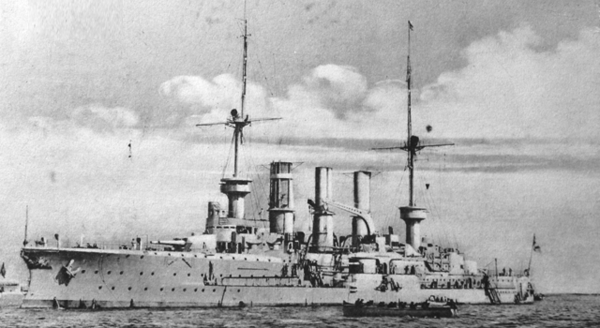
On 1 July 1915, SMS Albatross, Roon, Augsburg, Lübeck and seven destroyers were laying a minefield off Bogskär and separated afterwards, Augsburg and Albatross were intercepted by Rear Admiral Bakhirev’s Russian squadron. Flotilla Cdr. Johannes von Karpf ordered Albatross to reach neutral Swedish waters while Roon and Lübeck were called in reinforcement. Albatross eventually was gounded off Gotland and Roon was catch up and exchanged fire with the Russians briefly. Hopman sailed with Prinz Adalbert and Prinz Heinrich in support and en route they were ambushed by the British submarine E9. She managed to hit Prinz Adalbert. The torpedo struck under the waterline at the hight of the forward conning tower. Ten men were killed in the explosion and damage was severe. Kt.Admiral Hopman was transferred on V99, while captain Michelsen remained on board to supervise repairs and return to port. The repair teams managed to stop the leakages but the ship steamed with 2,000 t of seawater, and her draft was such she could not made it into Danzig and instead went to Kiel for repairs on 4 July.
Out of the drydock on September 1915 she was prepared for a sortie to the Gulf of Finland with SMS Braunschweig, Elsass, Mecklenburg, Schwaben, and Zähringen, preceded by their scout, SMS Bremen. The sweep was inconclusive, as the next on 5 October, to cover this time a minelayer operating off Östergarn. On 19 October, Prinz Adalbert was no longer admiral ship, passed on to Roon. She started a patrol between Fårö and Dagerort, and while 20 miles west of Libau on 23 October she was ambushed by the submarine E8. Firing at 1,200 m her torpedo spread struck at the level of the ship’s ammunition magazine, causing a massive explosion. Broke in two, Prinz Adalbert sank with all but three survivors, at the time, the greatest single loss of life for the German Baltic forces.
SMS Friedrich Carl in action
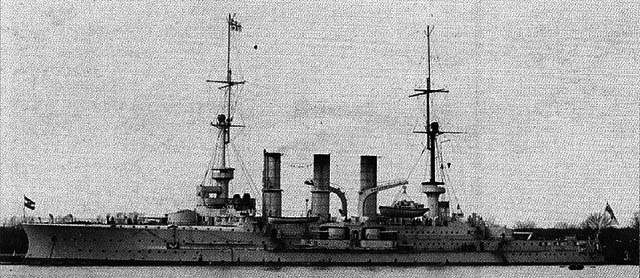
SMS Friedric Carl photo by Max Dreblow
As the Emperor’s escort 1904-1905
SMS Friedrich Carl’s official sea trials were interrupted in March 1904 when tasked to escort Kaiser Wilhelm II’s Norddeutscher Lloyd steamer SS König Albert. This was her first shakedown cruise, and it was spent in the Mediterranean Sea. On 12 March, she departed Bremerhaven for Vigo in Spain for a state visit to the Spanish king Alfonso XIII. The latter was a guest onboard Friedrich Carl on 15 March. Sjhe later stopped in Gibraltar, saluting the British Channel Squadron, then Naples and the way of Mahón. There, on 24 March, Wilhelm II boarded his Royal yacht Hohenzollern. The cruiser was visited by King Victor Emmanuel III. However the cruiser was in need of post-trials refit and left for home. She stopped in Venice en route on 7 May and was in Kiel, on 17 May, assigned to the reconnaissance force, replacing the protected cruiser Victoria Louise.
From June 1904, Friedrich Carl was affected to II Squadron, touring Dutch, British, and Norwegian ports until August, towing at some point two torpedo boats to Stavanger in Norway. She took place in annual maneuvers for August-September in the North sea, and Baltic Sea. In September 1904, Captain Merten was replaced by Fregattenkapitän Hugo von Cotzhausen. At last, the cruiser’s sea trials officially ended, and she already had quite a mileage. In November 1904 was reported in her logbook a short-lived mutiny. KAdm Gustav Schmidt became commander of reconnaissance forces of the Active Battlefleet, transferring his mark on Friedrich Carl, as flagship of the reconnaissance squadron.
In January-February 1905, SMS Friedrich Carl was participating in training exercises in the Baltic while she struck a submerged shipwreck north of the Great Belt. Damage was light and she was able to proceed. From 23 March, she escorted the Kaiser in his new state visit in the Mediterranean onboard SS Hamburg. When in Lisbon, the cruiser hosted King Carlos I of Portugal. At the advice of German Chancellor Bernhard von Bülow, the ships departed to Morocco and arrived in Tangiers on 31 March, saluting the French cruisers Du Chayla and Linois. The Kaiser’s speech there was supporting Moroccan independence, leading to the First Moroccan Crisis. The ships depated and stopped in Gibraltar, seeing SMS Friedrich Carl colliding without much gravity with HMS Prince George. She was back in Germany in June and was in maintenance on 10-26 August.
Prewar role in the reserve fleet
In July 1905 SMS Friedrich Carl was transferred in the Baltic Sea and ran aground underway, but damage was light. She took part in the squadron exercises at the end of the year and by February 1906, made a training cruise back to Denmark. SMS Yorck replaced her as squadron flagship by March while herself became flagship of the deputy commander, Kommodore Raimund Winkler, albeit briefly, replaced by Roon on 15 August. After the autumn manoeuvers, FregatteKaptain Franz von Hipper (yes, this one) took command and the cruiser resumed her role as deputy commander flagship. Captain Eugen Kalau vom Hofe became her new captain until March 1908. The preceding year, she had a collision with SMS Yorck and made a major training cruise into the Atlantic Ocean in 1908. She was decommissioned on 5 March for repairs and an overhaul.
She was back in active service on 1st March 1909 while KzS Friedrich Schultz took command. The cruiser was to be used as a torpedo test ship, replacing SMS Vineta, her captain heading also the Torpedo Testing Inspectorate. On 30 March, her tests were conducted off Rügen, in April 1909, until the 24th. She took part in the usual autumn manoeuvres in August-September, still affected in the Reconnaissance Group, Reserve Fleet, and the routine resumed in 1910, 1911, this time under command of KzS Ernst Ritter von Mann und Edler von Tiechler (September 1909), then KAdm Wilhelm von Lans (December 1909) and FK Andreas Michelsen (September 1911).
In July 1911, she took part in torpedo tests with SMS Augsburg in Norwegian waters. The severe winter of 1911–1912 saw her rescuing stranded merchant ships in pack ice. She later resumed her role as Testing Ship while KAdm Reinhard Koch took hoisted his mark on SMS Friedric Carl in October 1912. She was affected to the II Scouting Group, Hochseeflotte. 1913 and 1914 followed the same routine but on 6 April 1914, she ran aground off Swinemünde, but was pulled out free. She hosted Großadmiral Alfred von Tirpitz during the Kiel’s sailing regatta of July 1914, and saluting the also present British Royal Navy. This was onboard SMS Friedric Carl that Edward Goschen, British ambassador to Tirpitz informed him of the assassination of Archduke Franz Ferdinand. On 31 July, when the war was about to break out, SMS Friedrich Carl was in drydock at Kaiserliche Werft, Kiel.
A short wartime service in the Baltic
Indeed, on 28 August, the cruiser was at sea under command of KzS Max Schlicht, later replaced by FK Loesch, assigned to the Cruiser Division in the Baltic. She took place of the older cruiser Freya, hoisting the flagship mark of KAdm Robert Mischke. By late September 1914, she covered a minelaying operation off Langeland. She then became flagship of KAdm Ehler Behring, her squadron comprising the cruisers Vineta, Hertha, Hansa, Augsburg, Thetis, and Lübeck, plus attached torpedo boats and U-boats. Their base was Neufahrwasser, Danzig. SMS Friedrich Carl took part in her first wartime sortie, into the Gulf of Finland, on 24 October 1914. They missed the Russians, but some British submarines were signalled. Since her last immobilization she carried two seaplanes, with summary accomodations for reconnaissance. On 30 October she took part in another inconclusive sweep without success. By early November 1914, she was withdrawn for short repairs and afterwards was ordered to attack the Russian port at Libau. The German HQ feared it would be turned with Russian help into a British submarine base. Friedrich Carl left Memel on 16 November, and made night trip to arrive off Libau when at 01:46, on 17 November, just 33 nautical miles west off Memel she struck a mine laid down by the Russians in October. The crew at first thought of a submarine hit, and she ship veered down to head for Memel whe she struck a second mine at 01:57. Her damage control team managed to keep her afloat until 6:20, when the captain ordered to abandon ship. SMS Augsburg arrived and evacuated the crew. She ship disappeared from view at 07:15 and only lost 8, killed in the explosion and sinking, in stark contrast to her sister ship.

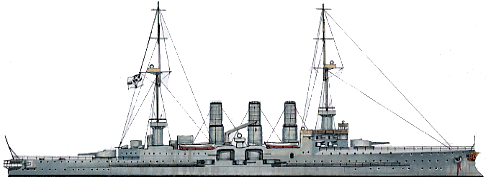
 Latest Facebook Entry -
Latest Facebook Entry -  Pinterest Board
Pinterest Board




 Austrian Navy
Austrian Navy French Navy
French Navy Royal Navy
Royal Navy Armada Espanola
Armada Espanola K.u.K. Kriegsmarine
K.u.K. Kriegsmarine Dansk Marine
Dansk Marine Nautiko Hellenon
Nautiko Hellenon Koninklije Marine 1870
Koninklije Marine 1870 Marinha do Brasil
Marinha do Brasil Osmanlı Donanması
Osmanlı Donanması Marina Do Peru
Marina Do Peru Marinha do Portugal
Marinha do Portugal Regia Marina 1870
Regia Marina 1870 Nihhon Kaigun 1870
Nihhon Kaigun 1870 Preußische Marine 1870
Preußische Marine 1870 Russkiy Flot 1870
Russkiy Flot 1870 Svenska marinen
Svenska marinen Søværnet
Søværnet Union Navy
Union Navy Confederate Navy
Confederate Navy Armada de Argentina
Armada de Argentina Imperial Chinese Navy
Imperial Chinese Navy Marinha do Portugal
Marinha do Portugal Mexico
Mexico Kaiserliche Marine
Kaiserliche Marine 1898 US Navy
1898 US Navy Russkiy Flot
Russkiy Flot French Naval Aviation
French Naval Aviation Russian Naval Aviation
Russian Naval Aviation Sovietskiy Flot
Sovietskiy Flot Royal Canadian Navy
Royal Canadian Navy Royal Australian Navy
Royal Australian Navy RNZN Fleet
RNZN Fleet Chinese Navy 1937
Chinese Navy 1937 Kriegsmarine
Kriegsmarine Chilean Navy
Chilean Navy Danish Navy
Danish Navy Finnish Navy
Finnish Navy Hellenic Navy
Hellenic Navy Polish Navy
Polish Navy Romanian Navy
Romanian Navy Turkish Navy
Turkish Navy Royal Yugoslav Navy
Royal Yugoslav Navy Royal Thai Navy
Royal Thai Navy Minor Navies
Minor Navies Albania
Albania Austria
Austria Belgium
Belgium Columbia
Columbia Costa Rica
Costa Rica Cuba
Cuba Czechoslovakia
Czechoslovakia Dominican Republic
Dominican Republic Haiti
Haiti Hungary
Hungary Honduras
Honduras Estonia
Estonia Iceland
Iceland Eire
Eire Equador
Equador Iran
Iran Iraq
Iraq Latvia
Latvia Liberia
Liberia Lithuania
Lithuania Mandchukuo
Mandchukuo Morocco
Morocco Nicaragua
Nicaragua Persia
Persia San Salvador
San Salvador Sarawak
Sarawak Uruguay
Uruguay Venezuela
Venezuela Zanzibar
Zanzibar Warsaw Pact Navies
Warsaw Pact Navies Bulgaria
Bulgaria Hungary
Hungary

 Bundesmarine
Bundesmarine Dutch Navy
Dutch Navy Hellenic Navy
Hellenic Navy Marina Militare
Marina Militare Taiwanese Navy
Taiwanese Navy Chinese Navy
Chinese Navy Indian Navy
Indian Navy Indonesian Navy
Indonesian Navy JMSDF
JMSDF North Korean Navy
North Korean Navy Philippines Navy
Philippines Navy ROKN
ROKN IDF Navy
IDF Navy Royal New Zealand Navy
Royal New Zealand Navy Egyptian Navy
Egyptian Navy South African Navy
South African Navy

































 RN
RN
 Marine Nationale
Marine Nationale
 Soviet Navy
Soviet Navy
 dbodesign
dbodesign